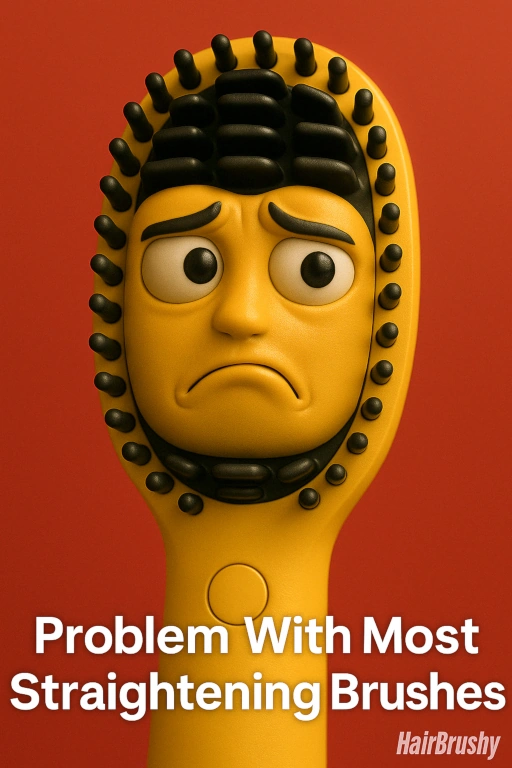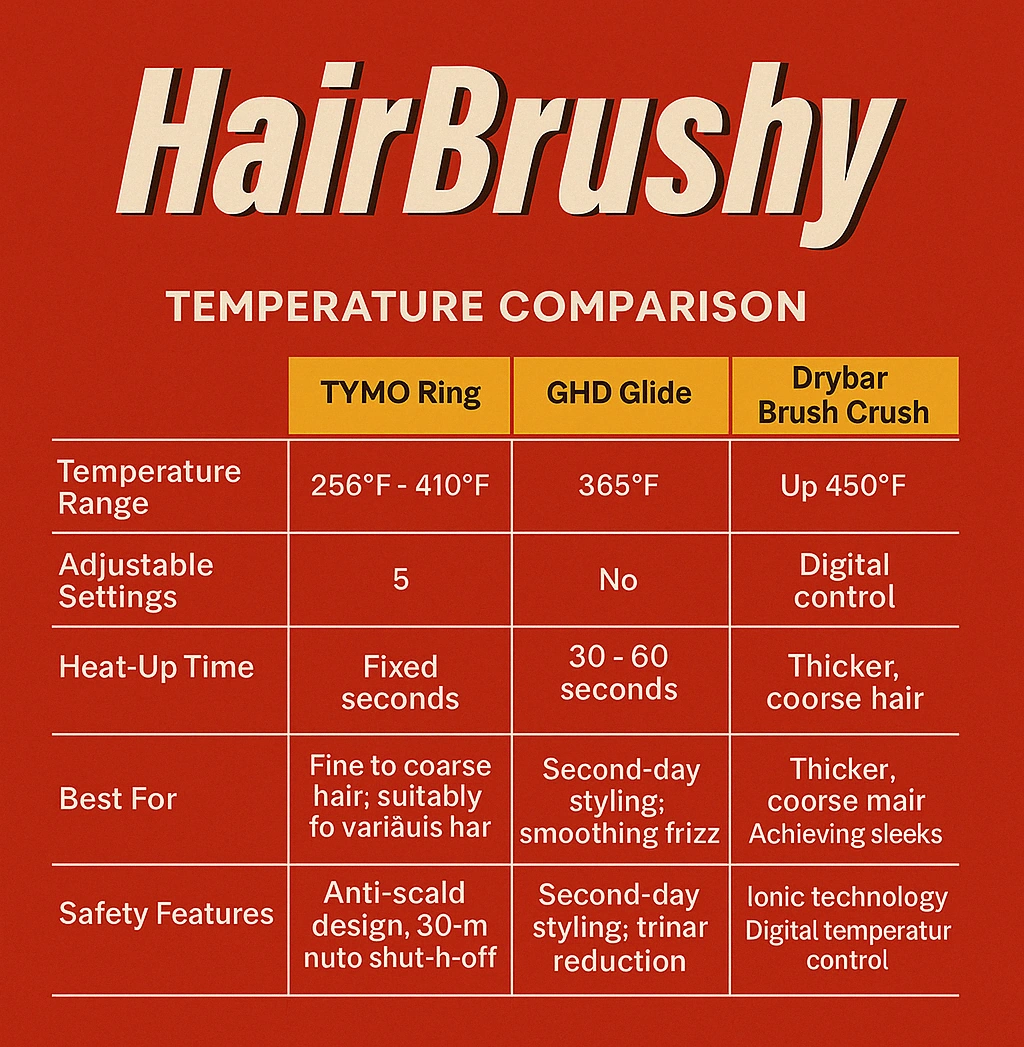When I turned 40 suddenly my hair stopped cooperating. This is no joke. It got finer, drier, and heat tools that once worked left me with split ends and either flat or frizzy hair. Sound familiar? I wish I had this article on straightening brushes when I was 40!!!
If you’re over 40 with fine or thinning hair, and looking for a straightening brush that won’t fry it, this article’s for you.
Why Hair Changes After 40
My big question was what really changed on me to cause this problem in the first place. I thought once I understand what happened then I can make adjustments to help.
1 Hormonal Shifts (Hello, Menopause!)
As estrogen and progesterone levels decline, your hair may respond with thinning, shedding, or even growing in new textures. These hormones help maintain the hair growth cycle and keep strands lush and full. As they drop off, hair follicles enter their resting phase more quickly, meaning more shedding and less regrowth.
What this means for your brush: You’ll need something gentler, with controlled heat and less tugging, to avoid unnecessary breakage.
2 Slower Oil Production → Drier, More Brittle Hair
Sebum (your scalp’s natural oil) production slows down as we age. While that might have been a dream come true during your teen years, it’s less exciting when your hair starts feeling dry, rough, or prone to frizz.
The challenge: Dry hair is more vulnerable to heat damage. Even a “low” setting on some brushes can cause split ends or breakage if your strands are already dehydrated.
3 Hair Follicle Shrinkage → Finer Texture
Hair follicles tend to miniaturize with age, producing thinner strands, even if you had thick, coarse hair before. This is one reason women over 40 often say their ponytail feels “thinner.”
Why it matters: Finer hair requires lower temperatures and softer brush bristles. Otherwise, you risk flattening it or losing precious volume.
4 Increased Heat Sensitivity
As your hair changes in structure and moisture levels, it becomes more sensitive to styling tools. That means heat tools that were once safe can now cause more harm than good.
What to avoid: Straighteners with fixed temps (especially anything over 400°F) and brushes without ceramic coating. These can easily over-dry or fry delicate, aging strands.
The Problem With Most Straightening Brushes

So in my experience, and I’ve tried a lot of straightening brushes, all from the cheapest to very expensive. And here is what I found out most hair straightening brushes aren’t made with fine, over-40 hair in mind. Yep, that is the hard truth!
They’re typically engineered for thicker, coarser hair types that can handle high heat and aggressive styling. If you have delicate or thinning hair, most are no good. Here is my list of things I’ve noted over the years on where they (most straightening brushes) tend to go wrong:
They Run Too Hot
Most mainstream brushes start at 350°F or higher and that’s just the low setting. Yes, you heard right, that is the LOW setting!!! Fine hair doesn’t need that much heat. In fact, anything over 300°F can start to weaken your strands, causing dryness, brittleness, or even split ends.
My experience: One brush I tried had a single setting 400°F. After just one week of use, my hair felt like straw and looked completely fried at the ends.
Poor Temperature Control
In all the brushes I used and tested over the years many budget or off-brand brushes don’t have reliable temp regulation. They either overheat while in use or display inaccurate temperatures. That means your brush could be hotter than it claims, which is bad news for fragile strands. Sometimes you will get luckily and get a good budget straightening brush. But in my experience there is NO consistency
What to look for instead: A brush with precise digital controls and a wide temperature range, especially one that goes as low as 250°F. This is key!!! Your fine hair will thank you later for this one feature.
What to Look For in a Brush (Quick Checklist)
So here is my check list and what I look for in a straightening brush. I’ve compiled a list of features over the years based on my fine hair, being over 40 and what I have found that really works.
- Lightweight design for wrist comfort
- Adjustable heat settings (lowest should be under 300°F)
- Ceramic or tourmaline-coated bristles
- Soft bristles for less tugging
- Auto shut-off (bonus if you’re forgetful, like me)
My Recommendation

After evaluating various options over the years, my top recommendation for a hair straightening brush suitable for fine, over-40 hair is the TYMO Ring Hair Straightening Brush. I have found by using this brush it combines the functionality of a comb and flat iron, delivering a sleek hairstyle in a single pass. It features PTC heating and 3D brush teeth, ensuring even heat distribution and reducing heat damage by 50%. With five adjustable heat settings, (in my experience I have found it is really good to have that much control over the temperature) it caters to different hair types, and its anti-scald design, along with auto-off features, enhances safety. The brush heats up in just 20 seconds, saving time during your morning routine. Additionally, it comes with a detangling brush, clips, a heatproof glove, and a travel bag, making it convenient for both home and travel.
Affiliate Link: Check Price – TYMO Ring Hair Straightening Brush on Amazon
Now if you have thicker hair then you have more options. But I have found people like me with fine thin hair, a little temperature goes a long way.
References: https://tymobeauty.com
Temperature Comparison: Hair Straightening Brushes

| Feature | TYMO Ring | GHD Glide | Drybar Brush Crush |
|---|---|---|---|
| Temperature Range | 266°F – 410°F (130°C – 210°C) | 365°F (185°C) fixed | Up to 450°F (232°C) |
| Adjustable Settings | 5 heat settings | No (single fixed temperature) | Yes (digital control) |
| Heat-Up Time | 20 seconds | 30–60 seconds | Varies; heats quickly |
| Best For | Fine to coarse hair; suitable for various hair types | Second-day styling; smoothing frizz | Thicker, coarse hair; achieving sleek styles |
| Safety Features | Anti-scald design; 30-minute auto shut-off | Automatic sleep mode after 60 minutes | 60-minute automatic shut-off |
| Additional Features | Dual voltage; includes accessories like glove and clips | Ceramic technology with ionizer for frizz reduction | Ionic technology; digital temperature control |
Fun Fact: Egg Frying Temperature

OK, just for fun and to put temperature into context, frying an egg typically requires a surface temperature of around 250°F to 325°F (121°C to 163°C). Wow!!! Ha, just think about that, while straightening you hair you could also be cooking breakfast, ha!!!
This comparison highlights that some hair straightening brushes operate at temperatures higher than what’s needed to cook an egg, emphasizing the importance of choosing appropriate heat settings to prevent hair damage. No wonder my hair was complaining.

